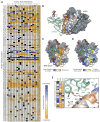Engineering human ACE2 to optimize binding to the spike protein of SARS coronavirus 2
- PMID: 32753553
- PMCID: PMC7574912
- DOI: 10.1126/science.abc0870
Engineering human ACE2 to optimize binding to the spike protein of SARS coronavirus 2
Abstract
The spike (S) protein of severe acute respiratory syndrome coronavirus 2 (SARS-CoV-2) binds angiotensin-converting enzyme 2 (ACE2) on host cells to initiate entry, and soluble ACE2 is a therapeutic candidate that neutralizes infection by acting as a decoy. By using deep mutagenesis, mutations in ACE2 that increase S binding are found across the interaction surface, in the asparagine 90-glycosylation motif and at buried sites. The mutational landscape provides a blueprint for understanding the specificity of the interaction between ACE2 and S and for engineering high-affinity decoy receptors. Combining mutations gives ACE2 variants with affinities that rival those of monoclonal antibodies. A stable dimeric variant shows potent SARS-CoV-2 and -1 neutralization in vitro. The engineered receptor is catalytically active, and its close similarity with the native receptor may limit the potential for viral escape.
Copyright © 2020 The Authors, some rights reserved; exclusive licensee American Association for the Advancement of Science. No claim to original U.S. Government Works.
Figures




Update of
-
The sequence of human ACE2 is suboptimal for binding the S spike protein of SARS coronavirus 2.bioRxiv [Preprint]. 2020 May 11:2020.03.16.994236. doi: 10.1101/2020.03.16.994236. bioRxiv. 2020. Update in: Science. 2020 Sep 4;369(6508):1261-1265. doi: 10.1126/science.abc0870. PMID: 32511321 Free PMC article. Updated. Preprint.
Comment in
-
A molecular trap against COVID-19.Science. 2020 Sep 4;369(6508):1167-1168. doi: 10.1126/science.abe0010. Science. 2020. PMID: 32883851 No abstract available.
-
Outsmarting SARS-CoV-2 by empowering a decoy ACE2.Signal Transduct Target Ther. 2020 Nov 3;5(1):260. doi: 10.1038/s41392-020-00370-w. Signal Transduct Target Ther. 2020. PMID: 33144557 Free PMC article. No abstract available.
Similar articles
-
Investigation of the genetic variation in ACE2 on the structural recognition by the novel coronavirus (SARS-CoV-2).J Transl Med. 2020 Aug 24;18(1):321. doi: 10.1186/s12967-020-02486-7. J Transl Med. 2020. PMID: 32831104 Free PMC article.
-
Highly conserved binding region of ACE2 as a receptor for SARS-CoV-2 between humans and mammals.Vet Q. 2020 Dec;40(1):243-249. doi: 10.1080/01652176.2020.1823522. Vet Q. 2020. PMID: 32921279 Free PMC article.
-
Enhanced Binding of SARS-CoV-2 Spike Protein to Receptor by Distal Polybasic Cleavage Sites.ACS Nano. 2020 Aug 25;14(8):10616-10623. doi: 10.1021/acsnano.0c04798. Epub 2020 Aug 4. ACS Nano. 2020. PMID: 32806067
-
Mass Spectrometry and Structural Biology Techniques in the Studies on the Coronavirus-Receptor Interaction.Molecules. 2020 Sep 10;25(18):4133. doi: 10.3390/molecules25184133. Molecules. 2020. PMID: 32927621 Free PMC article. Review.
-
ACE2, the Receptor that Enables Infection by SARS-CoV-2: Biochemistry, Structure, Allostery and Evaluation of the Potential Development of ACE2 Modulators.ChemMedChem. 2020 Sep 16;15(18):1682-1690. doi: 10.1002/cmdc.202000368. Epub 2020 Aug 11. ChemMedChem. 2020. PMID: 32663362 Free PMC article. Review.
Cited by
-
Repurposing the Ebola and Marburg Virus Inhibitors Tilorone, Quinacrine, and Pyronaridine: In Vitro Activity against SARS-CoV-2 and Potential Mechanisms.ACS Omega. 2021 Mar 10;6(11):7454-7468. doi: 10.1021/acsomega.0c05996. eCollection 2021 Mar 23. ACS Omega. 2021. PMID: 33778258 Free PMC article.
-
A novel cell culture system modeling the SARS-CoV-2 life cycle.PLoS Pathog. 2021 Mar 12;17(3):e1009439. doi: 10.1371/journal.ppat.1009439. eCollection 2021 Mar. PLoS Pathog. 2021. PMID: 33711082 Free PMC article.
-
Targeting the SARS-CoV-2-spike protein: from antibodies to miniproteins and peptides.RSC Med Chem. 2020 Dec 17;12(2):197-202. doi: 10.1039/d0md00385a. RSC Med Chem. 2020. PMID: 34041482 Free PMC article. Review.
-
Bispecific VH/Fab antibodies targeting neutralizing and non-neutralizing Spike epitopes demonstrate enhanced potency against SARS-CoV-2.MAbs. 2021 Jan-Dec;13(1):1893426. doi: 10.1080/19420862.2021.1893426. MAbs. 2021. PMID: 33666135 Free PMC article.
-
The flexibility of ACE2 in the context of SARS-CoV-2 infection.bioRxiv [Preprint]. 2020 Sep 16:2020.09.16.300459. doi: 10.1101/2020.09.16.300459. bioRxiv. 2020. Update in: Biophys J. 2021 Mar 16;120(6):1072-1084. doi: 10.1016/j.bpj.2020.10.036. PMID: 32995769 Free PMC article. Updated. Preprint.
References
-
- Zhu N., Zhang D., Wang W., Li X., Yang B., Song J., Zhao X., Huang B., Shi W., Lu R., Niu P., Zhan F., Ma X., Wang D., Xu W., Wu G., Gao G. F., Tan W.; China Novel Coronavirus Investigating and Research Team , A Novel Coronavirus from Patients with Pneumonia in China, 2019. N. Engl. J. Med. 382, 727–733 (2020). 10.1056/NEJMoa2001017 - DOI - PMC - PubMed
-
- Zhou P., Yang X.-L., Wang X.-G., Hu B., Zhang L., Zhang W., Si H.-R., Zhu Y., Li B., Huang C.-L., Chen H.-D., Chen J., Luo Y., Guo H., Jiang R.-D., Liu M.-Q., Chen Y., Shen X.-R., Wang X., Zheng X.-S., Zhao K., Chen Q.-J., Deng F., Liu L.-L., Yan B., Zhan F.-X., Wang Y.-Y., Xiao G.-F., Shi Z.-L., A pneumonia outbreak associated with a new coronavirus of probable bat origin. Nature 579, 270–273 (2020). 10.1038/s41586-020-2012-7 - DOI - PMC - PubMed
-
- Peiris J. S. M., Lai S. T., Poon L. L. M., Guan Y., Yam L. Y. C., Lim W., Nicholls J., Yee W. K. S., Yan W. W., Cheung M. T., Cheng V. C. C., Chan K. H., Tsang D. N. C., Yung R. W. H., Ng T. K., Yuen K. Y.; SARS study group , Coronavirus as a possible cause of severe acute respiratory syndrome. Lancet 361, 1319–1325 (2003). 10.1016/S0140-6736(03)13077-2 - DOI - PMC - PubMed
-
- Huang C., Wang Y., Li X., Ren L., Zhao J., Hu Y., Zhang L., Fan G., Xu J., Gu X., Cheng Z., Yu T., Xia J., Wei Y., Wu W., Xie X., Yin W., Li H., Liu M., Xiao Y., Gao H., Guo L., Xie J., Wang G., Jiang R., Gao Z., Jin Q., Wang J., Cao B., Clinical features of patients infected with 2019 novel coronavirus in Wuhan, China. Lancet 395, 497–506 (2020). 10.1016/S0140-6736(20)30183-5 - DOI - PMC - PubMed
Publication types
MeSH terms
Substances
Grants and funding
LinkOut - more resources
Full Text Sources
Other Literature Sources
Molecular Biology Databases
Research Materials
Miscellaneous

